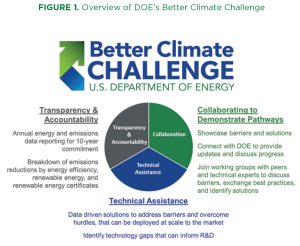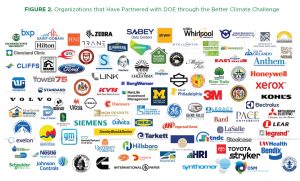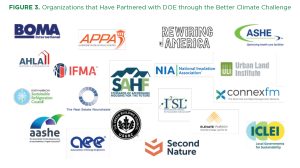How Your Organization Can Partner with the U.S. Department of Energy to Reduce Greenhouse Gas Emissions
A clean and efficient energy economy is essential for mitigating the worst impacts of climate change while achieving energy independence and creating high-paying American jobs. To support this mission, DOE strategically invests in research, development, demonstration, and deployment of clean energy and decarbonization technologies. DOE also partners with leaders in the public and private sectors to improve energy efficiency and reduce greenhouse gas (GHG) emissions of the nation’s commercial buildings and industrial plants. These efforts, and the solutions shared by others, can help you and your organization.
For example, through DOE’s Better Buildings, Better Plants Initiative, more than 900 organizations have partnered with DOE to collectively save $15 billion and avoid 155 million metric tons of CO2, which is roughly equivalent to the amount of emissions produced by 33,000,000 gasoline-powered cars driven for 1 year.1 In addition, these partners have shared more than 3,000 innovative solutions that have accelerated the adoption of energy-efficiency technologies and strategies across the building and industrial sectors.
Energy-efficiency measures are some of most cost-effective and ready-to-implement pathways to decarbonization, and they can lead to substantial cost savings for organizations. The insulation industry understands this well, as mechanical insulation can reduce heat loss from pipes by an average of 95% annually, saving $417 in fuel costs and reducing CO2-eq emissions by 2,309 lbs. for each foot of insulation.2 Through public-private partnerships, DOE strives to accelerate the adoption of energy-saving solutions such as insulation to help organizations reduce energy costs and GHG emissions.
Working in Partnership to Address Climate Change: DOE’s Better Climate Challenge
Buildings and manufacturing plants account for approximately two-thirds of U.S. carbon emissions. To support the decarbonization of these critical sectors, DOE launched the Better Climate Challenge (see Figure 1), which challenges companies, states, municipalities, and other organizations to set ambitious, portfolio-wide GHG-reduction goals and share real-world pathways to mitigate the impacts of climate change. Through this public-private partnership, DOE supports participating organizations by providing a national platform that offers technical assistance, tools for transparency and accountability, and collaboration opportunities to identify decarbonization pathways and accelerate the nation toward its GHG emissions-reduction goals and a clean energy economy. Any organization that owns or operates a portfolio of buildings/plants/multifamily housing in the United States is welcome to join the Better Climate Challenge.
Organizations that partner with DOE through the Better Climate Challenge commit to reducing their Scope 1 and 2 GHG emissions by at least 50% over 10 years, without the use of carbon offsets. Organizations also aim to improve energy efficiency through anadditional target. Energy-intensive industries—including petroleum refining and chemical, iron and steel, food and beverage, and cement manufacturing—are asked to commit to at least a 25% reduction in Scope 1 and 2 GHG emissions.
Benefits of Participating in the Better Climate Challenge Partnership
More than 100 organizations, like NIA members Kingspan, 3M, and Saint-Gobain, have already joined the Better Climate Challenge, representing a broad range of sectors across the U.S. economy, including state and local governments, multifamily housing, universities, manufacturers, data centers, commercial buildings, and Fortune 500 companies. These partners understand the multitude of benefits that are provided through public-private partnerships that enable organizations to collaborate and share best practices for decarbonization pathways. DOE looks forward to highlighting what leading partners are doing to successfully decarbonize buildings and manufacturing facilities.
Through the Better Climate Challenge, DOE provides direct support and technical assistance to help partners throughout their decarbonization journey in key areas, including emissions accounting and baselining, developing a portfolio-wide GHG emissions-reduction plan, and implementing decarbonization projects and practices (see Figure 2). In this area, DOE pulls from extensive experience, leveraging DOE’s National Laboratories to provide subject matter expertise and technical assistance on a range of energy engineering topics through the Technical Account Managers of the Better Plants and Better Buildings programs.
Partner organizations aim to reduce their portfolio-wide carbon emissions by 50% over 10 years.
In addition, DOE supports peer-to-peer learning opportunities by providing partners with exclusive access to working groups that facilitate small group discussions around specific topics related to emissions reductions, such as electrification and portfolio-level emissions-reduction planning. Other opportunities for collaboration and knowledge sharing include trainings, webinars, regional meetups, conferences, and other events. In addition, DOE works with organizations to collect best practices and strategies for reducing emissions and highlight successful decarbonization pathways through case studies.
Lastly, DOE provides national recognition for partners that achieve program milestones and GHG emissions-reduction goals. Partner achievements are featured in DOE materials, publications, and at events and site visits. Case studies illustrating how partners have met their goals are broadcasted on the Better Buildings Solution Center, which is viewed by thousands of organizations and media outlets each year. Innovative accomplishments are also recognized annually through Better Practice & Better
Project Awards.
To learn more about the Better Climate Challenge and become a partner, visit https://betterbuildingssolutioncenter.energy.gov/climate-challenge/join.
Better Climate Challenge Allies
Non-profits, non-governmental organizations, and trade associations are invited to support the Better Climate Challenge by participating as Allies (see Figure 3). Allies, like NIA, partner with DOE to identify, recruit, and support organizations interested in reducing GHG emissions and sharing solutions. In addition, they commit to engaging with their members and stakeholders through executive-level announcements about the Better Climate Challenge. In return, DOE provides Allies with national recognition for their efforts and supports the organization and its members as they pursue emissions-reduction goals.
To learn more about Better Climate Challenge Allies and become an Ally, visit https://betterbuildingssolutioncenter.energy.gov/climate-challenge/allies.
In addition to the Better Climate Challenge, DOE offers a range of programs and resources that can help your organization decarbonize. Together, they aim to provide guidance and advanced technical support for prioritizing energy-efficiency measures, adopting emerging technologies, and leveraging renewables throughout your organization’s
decarbonization journey.
Beginning Your Decarbonization Journey
To provide further support to organizations seeking to reduce their GHG emissions, DOE has developed a wealth of no-cost resources that are designed to help partners develop decarbonization strategies, explore financing options, and implement successful projects. If you are just getting started in your decarbonization journey, we encourage you to explore the following resources.
Decarbonization Resource Hub
The Better Building’s Decarbonization Resource Hub is an excellent resource for organizations looking to begin their decarbonization journey. The hub includes information about decarbonization basics, guidance on goal setting and tracking progress, and recommendations on how to prioritize energy efficiency,
renewables, and emerging technologies.
Learn more at https://betterbuildingssolutioncenter.energy.gov/carbon-hub.
Low Carbon Tools and Calculators
DOE has developed multiple low carbon tools and calculators that aim to help industrial facilities reduce their carbon emissions. These tools include a Low Carbon Action Plan Tool that helps partners develop decarbonization pathways for selected plants, a Carbon Inventory Calculator that helps companies track carbon emissions, and an Electrification Impact Calculator that can be used to evaluate the cost and emissions reduction associated with replacing fuel-based equipment with electrical equipment.
To learn more about Better Plants’ no-cost software tools, visit https://betterbuildingssolutioncenter.energy.gov/better-plants/software-tools. Open-source software can be downloaded at DOE’s Advanced Manufacturing Office Github page: https://ornl-amo.github.io/. If you are interested in a demonstration or training, contact us at BetterPlants@ee.doe.gov.
Financing Navigator
DOE’s Financing Navigator allows organizations to evaluate a broad range of financing options for energy-efficiency and renewable-energy projects. The tool also facilitates user connections with the Financial Ally community of banks and lenders that are actively seeking energy-efficiency and renewable-energy projects to finance.
Learn more at https://betterbuildingssolutioncenter.energy.gov/financing-navigator.
Prioritizing Energy Efficiency
DOE recommends leading with energy-efficiency technologies and practices when pursuing a GHG emissions-reduction plan. Many organizations can achieve significant energy and cost savings by addressing low-hanging fruit, such as upgrading insulation systems, identifying leaks, and shutting down equipment during off shifts. These energy-saving opportunities, and more, can be uncovered through energy audits and by surveying operations in a facility. Organizations can further improve their energy performance by reclaiming wasted energy, upgrading inefficient systems, and implementing an energy management system.
Prioritizing energy efficiency makes the transition to renewable-energy infrastructure more cost-effective by minimizing the size and capacity required for the on-site renewable-energy project. If you are interested in improving your organization’s energy efficiency, we invite you to participate in the programs below.
Better Buildings, Better Plants Initiatives
DOE’s Better Buildings program supports buildings, cities, states, universities, and school districts as they commit to improving the energy efficiency of their building portfolio by at least 20% over 10 years. Similarly, the Better Plants program supports manufacturers and waste-treatment agencies that commit to improving their portfolio-wide energy intensity by 25% over 10 years. Through these programs, DOE provides expert technical assistance, access to innovation and resources, peer-to-peer exchange and networking opportunities, a network of allies, and national recognition for partner achievements.
To learn more about Better Buildings and/or become a partner, visit https://betterbuildingssolutioncenter.energy.gov.
To learn more about Better Plants and/or become a partner, visit https://betterbuildingssolutioncenter.energy.gov/better-plants or email BetterPlants@ee.doe.gov.
Industrial Assessment Centers
DOE’s 32 Industrial Assessment Centers (IACs) are an excellent resource for small- to medium-sized manufacturers that are interested in improving their energy performance, reducing energy costs, and/or taking the first step toward reducing their carbon emissions. The IACs perform no-cost energy assessments and make energy-saving recommendations for industrial facilities, leading to an average annual savings of $137,594.3 Mechanical insulation is one of the most frequent technologies called out for energy-efficiency improvements, and NIA has recently partnered with the IACs to educate people on insulation, inspections, and corrosion.
The IAC’s energy assessments are performed by university-based engineering students and faculty; therefore, IACs train the next generation of energy-engineering and energy-management workforce, with more than 60% of IAC student participants pursuing careers in the energy field following graduation.
To learn more about IACs and apply for an assessment, visit https://iac.university.
Implementing an Energy Management System
DOE offers support and recognition for organizations that implement an energy management system that adheres to the principles of the ISO 50001 standard, which is the global standard for energy management systems. DOE’s 50001 Ready program is self-paced, audit-free, and includes a “Turbo Tax-like tool” that provides partners with step-by-step guidance for implementing and maintaining an ISO 50001-based energy management system. DOE also offers elevated levels of recognition (at the Silver, Gold, or Platinum level) through its Superior Energy Performance 50001 program.
DOE is actively recruiting for its 50001 Ready Cohorts program, which provides tailored technical assistance to groups of energy team members at U.S.-based industrial, commercial, or institutional sites as they implement an ISO 50001-based energy management system. To learn more and apply, email 50001Ready@lbl.gov.
Combined Heat and Power Deployment
DOE offers comprehensive deployment support for combined heat and power (CHP) systems, which generate on-site electric power and thermal energy from a single fuel source and are capable of achieving efficiencies of up to 75%.4 The program provides advanced technical assistance through 10 regional CHP Technical Assistance Partnerships (TAPs) that provide unbiased, fact-based engineering support to industrial and commercial facilities that could benefit from deploying CHP, microgrids, and/or district energy technologies. The program also offers a breadth of no-cost resources, including a CHP Project Profiles Database and a CHP eCatalog that facilitates comparisons of different packaged CHP systems.
For more information and assistance, contact the CHP TAP in your area: https://betterbuildingssolutioncenter.energy.gov/chp/chp-taps.
MEASUR Software Suite
Manufacturing Energy Assessment Software for Utility Reduction (MEASUR) is a suite of no-cost, open-source software tools that allow industrial energy end users to model facility data, evaluate energy use, and improve industrial energy efficiency. The MEASUR software suite includes more than 70 calculators and assessment tools for a broad range of industrial processes, including pumping systems, process heating, fan systems, steam systems, and compressed air.
Learn more at https://www.energy.gov/eere/amo/measur.
Utilizing Emerging Technologies
New technologies are being developed to advance economy-wide decarbonization. DOE is supporting organizations that are interested in adopting pre- or early-commercial technologies that drive GHG emissions reductions in industry through the following program.
Industrial Technology Validation Pilot
DOE’s Better Plants program is currently offering validation support for emerging industrial decarbonization technologies through its Industrial Technology Validation Pilot. The aim of the program is to mitigate the risks associated with market adoption of emerging technologies by leveraging the expertise of the DOE National Labs to validate performance of pre- or early-commercial decarbonization technologies in real-world industrial environments. The pilot is open to technologies that will lead to substantial reduction in GHG emissions, energy use, water use, and/or waste creation and have broad deployment applicability in the manufacturing, wastewater treatment, agricultural, clean rooms, and/or mining sectors.
We are currently accepting applications for Phase 2 of the Industrial Technology Validation Pilot through August 15th. Learn more and apply at https://betterbuildingssolutioncenter.energy.gov/better-plants/industrial-technology-validation-pilot.
Leveraging Renewables
After your organization’s energy demand has been reduced through energy-efficiency practices and technologies, on-site renewable energy technologies can be leveraged to further reduce GHG emissions. Renewable energy presents several advantages over fossil fuel energy, including environmental, economic, and corporate social responsibility benefits. If you are interested in leveraging renewable energy technologies for your organization, we encourage you to explore the resources below.
Renewable Energy Resource Hub
The Better Building’s Renewable Energy Resource Hub provides a suite of information and resources that help organizations evaluate, finance, and implement on-site renewable-energy projects. The hub also includes guidance for evaluating if solar photovoltaic systems make sense for your organization, as well as resources to help navigate the utility, regulatory, and policy barriers to renewable energy.
Learn more at https://betterbuildingssolutioncenter.energy.gov/renewables.
Renewable Energy Guidance for Industry
DOE has developed a guidance document for industry that provides background on renewable technologies and their benefits, as well as information on the range of purchasing options available to organizations. The document also describes tools and resources for evaluating renewable-energy systems, as well as case studies that highlight how Better Plants partners have implemented various renewable-energy technologies.
View the guidance document here: https://betterbuildingssolutioncenter.energy.gov/resources/renewable-energy-guidance-industry.
REopt Web-Based Tool
The Renewable Energy Integration & Optimization (REopt) web-based tool allows energy end users to easily conduct a techno-economic feasibility analysis for different renewable-energy project options at their specific site. The tool identifies the most cost-effective mix of technologies that will enable the site to achieve the goals users input into the system.
Learn more at https://reopt.nrel.gov/tool.
Support for Energy-Intensive Industries
DOE’s Advanced Manufacturing Office is dedicated to supporting energy-intensive organizations throughout their decarbonization journey and is actively developing resources to support energy-efficiency improvements and emissions reductions in these critical sectors. These industries—which include petroleum refining and chemical, iron and steel, food and beverage, and cement manufacturing—account for a significant share of energy consumption and GHG emissions in the industrial sector. DOE recognizes that these industries are particularly difficult to decarbonize for a number of reasons, including process emissions, high-temperature heat requirements, diversity of industrial processing steps, and high capital investments on equipment with long lifetimes.
If you are interested in learning more about how DOE can support your energy-intensive
organization, please reach out to Bruce Lung at Robert.Lung@ee.doe.gov.
Partner with DOE
DOE is committed to supporting the nation’s commercial buildings and industrial plants in their decarbonization journey. We are very interested in partnering with you and are happy to meet with you to learn about your specific needs and challenges. If you are interested in connecting with us, please reach out to Jillian Romsdahl at jillian.romsdahl@ee.doe.gov.
References:
1. U.S. Department of Energy, 2022, “Better Buildings Progress Report: Stepping Up to the Challenge Together.”
https://betterbuildingssolutioncenter.energy.gov/sites/default/files/attachments/DOE_BBI_2022_Progress_Report.pdf
2. Crall, Christopher P., “Insulation—Still Greener than Trees!”, Insulation Outlook, September 1, 2021. https://insulation.org/io/articles/insulation-still-greener-than-trees/
3. U.S. Department of Energy, Advanced Manufacturing Office Industrial Assessment Center Newsletter, Winter 2021. www.energy.gov/sites/default/files/2021-07/IAC%20Winter%202021%20Newsletter_7.6.2021_FINAL.pdf
4. U.S. Department of Energy and U.S. Environmental Protection Agency, August 2012. Combined Heat and Power: A Clean Energy Solution. https://betterbuildingssolutioncenter.energy.gov/sites/default/files/attachments/chp_clean_energy_solution_0.pdf




